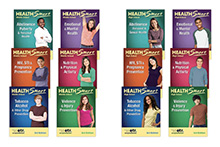How HealthSmart Meets the Characteristics of an Effective Health Education Curriculum
HealthSmart meets the 15 Characteristics of an Effective Health Education Curriculum defined by the CDC.
HealthSmart:
- Focuses on clear health goals and related behavioral outcomes. HealthSmart has clear health-related goals and behavioral outcomes. The instructional strategies and learning experiences are directly related to the behavioral outcomes. Lesson objectives spell out the knowledge and skills students will gain, and support the healthy behavior outcomes identified by the CDC.
- Is research-based and theory-driven. Effective curricula have instructional strategies and learning experiences built on theoretical approaches that have effectively influenced health-related behaviors among youth. HealthSmart is grounded in sound educational and behavioral theory. The Theory of Planned Behavior provides the framework for lessons and activities; concepts from Social Learning Theory are strategically woven throughout the program; and the Transtheoretical or Stages of Change Model serves as the foundation for activities designed to support student change of unhealthy behaviors. The program helps students analyze influences on their behaviors, supports the establishment of healthy peer norms and builds skills.
- Addresses individual values, attitudes and beliefs. HealthSmart fosters attitudes, values and beliefs that support positive health behaviors. Lessons help motivate students to examine their personal beliefs, attitudes and values, and understand their own risk behaviors, in support of adopting health-enhancing actions.
- Addresses individual and group norms that support health-enhancing behaviors. HealthSmart lessons cover current youth norms around a variety of health behaviors, such as injury, sexual activity and substance use, to reinforce positive norms and help students understand how misperceptions of those norms can affect their health-related behaviors.
- Focuses on reinforcing protective factors and increasing perceptions of personal risk and harmfulness of engaging in specific unhealthy practices and behaviors. Students have opportunities to assess their own risks and positive health behaviors throughout the HealthSmart lessons. They also examine influences that can support positive health behaviors, as well as those that can lead them to take risks.
- Addresses social pressures and influences. Analyzing influences is a key skill taught throughout the HealthSmart units. Students examine the effects of family, peers, culture, media and technology on their health choices and behaviors.
- Builds personal competence, social competence, and self-efficacy by addressing skills. HealthSmart is a skills-based curriculum. It addresses all of the key skills outlined in the National Health Education Standards, including analyzing influences, accessing accurate and credible resources, communicating clearly, resisting pressure using refusal and negotiation tactics, decision making, goal setting and self-management. This skills focus helps students build confidence, deal with pressures, and avoid or reduce risk behaviors. Each skill is thoroughly explained, discussed, modeled and practiced, with opportunities for students to receive feedback and reinforcement.
- Provides functional health knowledge that is basic, accurate, and directly contributes to health-promoting decisions and behaviors. The functional information in HealthSmart comes from accurate, reliable and credible sources and is taught in the context of improving knowledge and skills in order to practice healthy behaviors. Students are given ample opportunities to apply the information they are learning to their own lives in the interest of making health-enhancing choices.
- Uses strategies designed to personalize information and engage students. HealthSmart includes instructional strategies and learning experiences that are student-centered, interactive and experiential. Learning experiences correspond with students’ cognitive and emotional development, help them personalize information, and maintain their interest and motivation while accommodating diverse capabilities and learning styles. Instructional strategies and learning experiences include methods for:
- Addressing key health-related concepts
- Encouraging creative expression
- Sharing personal thoughts, feelings, and opinions
- Thoughtfully considering new arguments
- Developing critical thinking skills
- Provides age-appropriate and developmentally appropriate information, learning strategies, teaching methods and materials. HealthSmart addresses students’ needs, interests, concerns, developmental and emotional maturity levels, experiences, and current knowledge and skill levels. The lessons in each HealthSmart unit are designed to build the learning about the topic and help students apply their new knowledge and skills to their lives. Activities are grade-appropriate for each level of the program.
- Incorporates learning strategies, teaching methods and materials that are culturally inclusive. HealthSmart is designed to be unbiased and inclusive of diverse cultures and lifestyles. Differences are acknowledged. Case studies and roleplay scenarios in particular are written to be neutral and adaptable so that students can see themselves reflected. Family activities provide opportunities for parents and guardians to share in their children’s and teens’ learning and bring their own family values and perspectives to the discussions. Respect for differences is emphasized throughout the lessons, particularly in regard to sensitive health topics. Learning activities acknowledge the cultural diversity of students; optimize relevance to students from multiple cultures in the school community; and build on the cultural resources of families and communities.
- Provides adequate time for instruction and learning. The HealthSmart program is thorough. It is intended to build the learning on a particular health topic sequentially and logically to help ensure student mastery of concepts and skills. Behavior change requires an intensive and sustained effort.
- Provides opportunities to reinforce skills and positive health behaviors. HealthSmart builds on previously learned concepts and skills and provides opportunities to reinforce health-promoting skills across health topics and grade levels. Skill practice is often extended beyond a single activity or lesson, and students continue to practice and build their understanding and application of the skills. Each unit at the middle and high school levels includes a performance task unit assessment designed to reinforce the learning through a creative project that allows students to incorporate the skills they have learned.
- Provides opportunities to make positive connections with influential others. Take-home family sheets, surveys and interviews help students connect with trusted adults in their lives for information, advice and reinforcement of the concepts, skills and healthy behaviors. Suggestions for Community Connections help teachers find ways to reinforce and extend the learning by inviting community role models to the classroom.
- Includes teacher information and plans for professional development and training that enhance effectiveness of instruction and student learning. The pedagogically sound lessons guide teachers—even those with less experience—through each lesson step by step from preparation through assessment, and offer guidance for handling classroom discussions of difficult or controversial topics. The HealthSmart website offers HealthSmart teachers free access to Teacher Guide resources, content updates, articles and professional development materials, including a self-paced online orientation course. In-person and virtual training options are also available to school districts and youth-serving agencies that purchase the program.


